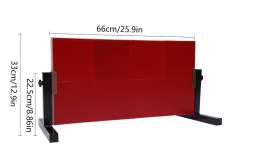So, I think, what you have to ask is, "What is the purpose of oiling a cutting board and is it different than the purpose for SEALING a blade?"
The truth of the matter is, you don't need to seal most well crafted blades. But some of the reasons why you might seal a blade are:
-Protect blade from the water in water based glue by providing a thin waterproof seal over the top ply.
-Protect top ply from damage when changing rubbers.
And what are the reasons for OILING a cutting board or wooden spoon?
-Keep the wood from drying, warping and cracking as a result of regular washing.
Now, for sure, you could put a cutting board oil on a blade. Here are things you could expect to occur as a result:
-Blade would be made a little heavier.
-Blade would become a little softer and it may lose some of its crispness, snap and pop depending on the blade.
Would cutting board oil protect the top ply from damage while changing rubbers? It is hard to say, but probably not. But it also probably would not make the top ply more subject to damage. Would the cutting board oil SEAL the top ply from penetration of water from the WBGlue? No. But it would make it so that the damage from the water had less of an impact.
One last detail here: A lot of the wood plies of blades are prepared with certain aging, drying and hardening processes that make the blade have more speed and snap, more crispness and pop. If you want a duller feeling blade with good touch, if you want to make your blade softer, the oil may be good for adding spin to your shots and short game. And if you want to keep the crispness and pop, if you want to keep the speed and power your blade has, I am not so sure you would want to use an oil that is designed to keep wood from drying out.
One more aside: part of the mystique of older blades, part of why old old blades, classic blades FEEL SOOOOOO GOOD, is that, in the normal course of things, a blade, as it ages, dries out and loses some of the moisture it has been holding. And as that happens the blade starts to feel better and better; crisper and more vibrant. If you want that to happen, you may not want to oil the blade. However, if you like the soft, dull feel of a Primorac and want even more of a soft, dull feeling, (and I happen to love the soft dull feeling of a good Primorac) then cutting board oil may be a great experiment.
I would try it on a blade you are not tooooooo attached to first though.
Thank you for your detailed answer! I certainly want more crisp feeling of the blade as well as the protection of the blade from the WBG. So do you think other oil based sealer will do that? I was thinking about using the hard wax oil by osmo, linseed oil or the Good Stuff wood finish.
I do not want to use shiny polyurethane stuffs since I’ve heard those stuffs harden the blade, don’t allow the moisture get out of the blade.
Could you recommend any other oil based sealer?













